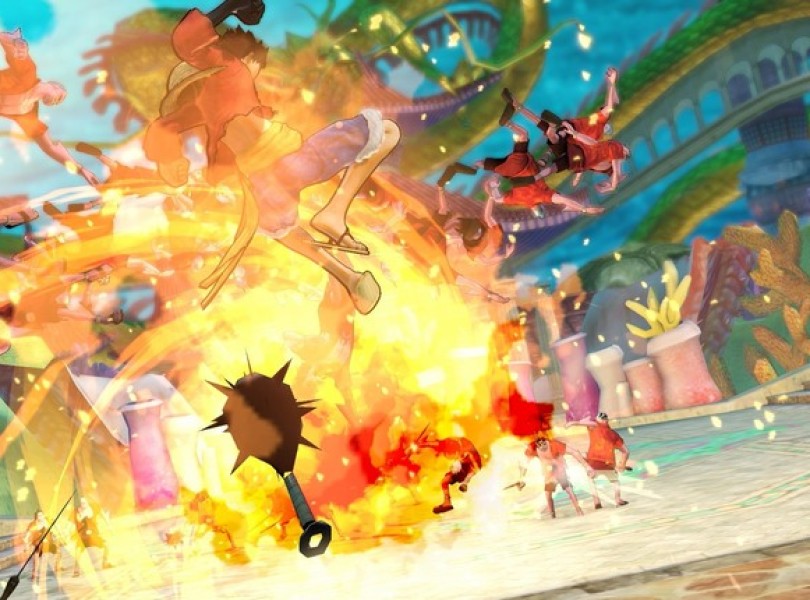All Chopper-ed up.
Like its predecessors, One Piece: Pirate Warriors 3 gives the Straw Hat Pirates the high-action Dynasty Warriors treatment, and it doesn’t change things too much this time around. In particular, the decent combat against hordes of enemies is largely the same as it is in One Piece: Pirate Warriors 2. However, unlike the last game, this one sticks to the canon One Piece story instead of telling a lackluster original one, and that sets it apart. It’s an extremely abridged story that has a bad habit of disrupting the battles just when they’re getting good, but Pirate Warriors 3 is fun overall and very well-suited to the waves-of-enemies “musou” style of battle.
One Piece the anime has reached over 700 episodes as of this writing, and it’s still going. That’s a lot of story to fit in 12 or so hours of an action-focused campaign, but Pirate Warriors 3 manages to do it — somehow — and even include an original ending. Even as I reached story arcs I barely remember or ones I haven’t seen, I still was able to follow along and, most importantly, enjoy it. I adore the world of One Piece, and none of that spirit is diminished in shortening the story. Saying goodbye to the Going Merry still gave me feels, and playing as Luffy really made me want to help his friends when they were in danger of dying in battle.
I sometimes felt like playing was a chore standing between me and the next chunk of plot.
Fitting in all this story context does come at a cost, however. Even though a lot of details are skipped or summarized, there’s still a lot of reading to do and cutscenes to watch. Battles are too frequently interrupted by these cutscenes, and the fighting drags as a result. Pirate Warriors 3 is a much faster way to experience One Piece than the manga or anime, but battles felt far longer than they actually were, and that didn’t help the sense of pacing. I usually like the steady, focused grind of a Dynasty Warriors-style battle up until its boss, but interruptions break up that focus and turn it into tedium. With that and the lower difficulty in the first half of the campaign, I sometimes felt like playing was a chore standing between me and the next chunk of plot, rather than letting the story enrich the gameplay.


Advertisement
Advertisement
Advertisement
Advertisement
Advertisement
Advertisement
That’s not to say that the battles themselves aren’t any fun, though. One Piece’s often over-the-top style suits the musou genre perfectly — each character’s set of attacks both makes sense for who or what the characters are and also for the Pirate Warriors’ kind of battle. All of them are capable of mowing down 50-plus enemies at once, and it’s consistently satisfying once the challenge picks up a little.
It looks pretty cool to destroy 100 enemies with one blow.
My favorite part of battling was experimenting with teammate combo attacks. Any crew member who’s taking part in a battle can be rotated into a kind of partner slot, and with the right combination of attacks, your partner will come in and strike with a finishing move. Playing as Luffy, I could “gatling gun” punch a swarm of opposing Marines and bring in the swordsman Zoro for the kill. Teaming up with the skeleton Brook launches a kind of musical attack, and Nami uses weather. It further enhances the crewmate solidarity aspect that’s so central to One Piece, and it looks pretty cool to destroy 100 enemies with one blow.
There’s also plenty to do in Pirate Warriors 3 outside of the main story. There’s a semi-random “dream log” mode, for example, in which you can unlock extras to help you level up your characters’ skills. It’s smart, because the only other option is grinding in completed story mode levels. It’s a nice break from the main campaign when needed, and playing as any unlocked character freely is always a nice touch.
Of all the ways to experience One Piece — a daunting task, considering how much of it there is — Pirate Warriors 3 isn’t a bad choice. It does its source material justice, and the heavily condensed canon story is as fun to experience as ever. One Piece’s unique style of fighting also translates quite well to musou combat, but fitting in the story bogs down that combat somewhat. Instead of enjoying both fighting and dialogue, it became a weird kind of chore to play through battles just to progress the story.



